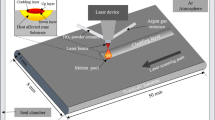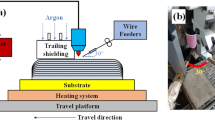Experimental diagnostics of the composition and structure of titanium diboride-containing materials obtained by self-propagating high-temperature synthesis from reaction mixtures of the titanium/ferrotitanium-ferroboron system is performed. Results of testing of specimens for compressive strength and wear resistance under dry friction against a fast abrasive are presented. The effect of 20 and 50 wt.% additions of copper or nickel to the initial reagents on the properties, structure and phase composition of the materials obtained is analyzed. It is shown that the materials without additions of copper and nickel have the highest wear resistance, while those containing Co and Ni have an elevated strength.


Similar content being viewed by others
References
S. N. Polevoy and V. D. Evdokimov, Hardening of Metals, A Reference Book [in Russian], Mashinostroenie, Moscow (1986), 320 p.
E. A. Levashov, A. S. Rogachev, V. I. Yukhvid, and I. P. Borovinskaya, Physicochemical and Technological Fundamentals of Self-Propagating High-Temperature Synthesis [in Russian], Izd. BINOM, Moscow (1999), 176 p.
C. Mroz, “Titanium diboride,” Am. Ceram. Soc. Bull., 74, 15 – 159 (1995).
V. S. Urbanovich, A. V. Kopylov, and V. A. Kukareko, “Physicomechanical properties of titanium diboride powder sintered at high pressure,” Fiz. Tekh. Vysok. Davl., 21(4), 77 – 85 (2011).
O. K. Lepakova, N. N. Golobokov, V. D. Kitler, et al., “Effect of mechanical activation and silicon additions on the structure and properties of materials sintered from SHS-composite TiB2 – Fe powder,” Fiz. Khim. Obrab. Mater., No. 1, 71 – 76 (2011).
O. K. Lepakova, O. G. Terekhova, V. A. Kostikova, and V. D. Kitler, “Formation of cermet in the process of mechanical activation of SHS-powder of TiB2 – Fe in benzine,” Khim. v Interesakh Ustoich. Razv., No. 4, 459 – 462 (2004).
Z. L. Zaki, Y. M. Z. Ahmed, and S. R. Abdel-Gawad, “In-situ synthesis of porous magnesia spinel/TiB2 composite by combustion technique” J. Ceram. Soc. Japan, 117(1366), 719 – 723 (2009).
N. I. Afanas’ev. N. I. Radushevskaya, O. K. Lepakova, et al., “SV-synthesis of TiB2 – MgAl2O4 composites for heat-resistant coatings,” Kosm. Appar. Tekhnol., 2, 3(2), 157 – 164 (2018).
Chao Li, Meishuan Li, Yanchun Zhou, et al., “In situ synthesis and properties of Ti3AlC2 /TiB2 composites,” J. Am. Ceram. Soc., 90(11), 3615 – 3620 (2007).
P. G. Ovcharenko, A. Yu. Leshchev, V. V. Tarasov, and N. A. Balobanov, “Effect of the composition of alloying coatings on the characteristics of surface layer in composite castings,” Metallurg, No. 11, 88 – 92 (2020).
L. G. Raskolenko, Yu. M. Maksimov, and O. K. Lepakova, “Construction of hypothetical Ti – B diagram by analysis of combustion products of three-component systems,” J. Mater. Synth. Proc., 3(3), 153 – 163 (1995).
O. K. Lepakova, L. G. Raskolenko, and Yu. M. Maksimov, “On the mechanism of phase and structure formation of the Ti – B – Fe system in combustion wave,” Fiz. Goreniya Vzryva, 36(5), 27 – 34 (2000).
O. A. Bannykh, N. B. Budberg, S. N. Alisov, et al. (eds.), Phase Diagrams of Binary and Multicomponent Iron-Base Systems [in Russian], Metallurgiya, Moscow (1986), 440 p.
P. G. Ovcharenko, A. Yu. Leshchev, and E. V. Kuz’minykh, “Method of fabrication of compact materials containing titanium diboride by self-propagating high-temperature synthesis, RF Patent No. 258566 S2, MPK C22C 29/14, B22F 3.23,” Byull. Izobr. Polezn. Modeli, No. 18 (2018), publ. 21.06.2018.
V. V. Tarasov, I. S. Trifonov, Yu. V. Puzanov, A. G. Bazhin, “Method for testing materials for abrasive wear, RF Patent No. 2601502, MPK G01N3/56,” Byull. Izobr. Polezn. Modeli, No. 31 (2016), publ. 10.11.2016.
O. K. Lepakova, L. G. Raskolenko, and Yu. M. Maksimov, “A study of the boride phases of titanium obtained by self-propagating high-temperature synthesis,” Neorganich. Mater., 36(6), 690 – 697 (2000).
G. V. Samsonov, T. I. Serebryakova, and V. A. Neronov, Borides [in Russian], Atomizdat, Moscow (1975), 376 p.
A. D. Sherman and A. A. Zhukov (eds.), Cast Iron [in Russian], Metallurgiya, Moscow (1991).
Author information
Authors and Affiliations
Corresponding author
Additional information
Translated from Metallovedenie i Termicheskaya Obrabotka Metallov, No. 11, pp. 55 – 59, November, 2021.
Rights and permissions
About this article
Cite this article
Ovcharenko, P.G., Makhneva, T.M., Leshchev, A.Y. et al. Effect of the Composition of Reaction Mixture on Characteristics of Compact Titanium Diboride-Containing Materials Obtained by Self-Propagating High-Temperature Synthesis. Met Sci Heat Treat 63, 629–633 (2022). https://doi.org/10.1007/s11041-022-00740-x
Published:
Issue Date:
DOI: https://doi.org/10.1007/s11041-022-00740-x




